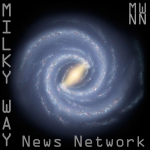“Johnny knew … he had the best seat in the house to watch the greatest explosion in the history of the solar system.” p. 309
First there was the big bang. By definition, nothing can match the initial outpouring of energy that we believe created the universe, but even today there are some pretty cataclysmic explosions. A supernova (the Star Blaze of the new book) happens when a large star reaches the end of its life. Stars fight a constant battle, the outward pressure from the nuclear reactions at their hearts counterbalancing the gravitational collapse due to all that matter being in one place. When the nuclear fuel runs out, there can be only one winner.
In that moment, the light from a single star outshines the rest of the galaxy that contains it. When you realize our own Milky Way contains at least 100 billion suns, we begin to understand just how bright and powerful a supernova really is. The image here is an artist’s vision of a supernova, based on Chandra X-Ray Telescope observations. Subramanian Chandrasekhar, who did more than anyone to enhance our understanding of stars and black holes, was one of the greatest scientists of last century. The telescope’s named after him, and I’m honoured that he called me his friend. At the start of Johnny Mackintosh: Star Blaze, I give the great man a name check.
It’s because of Chandra that we know our own Sun won’t, at some future stage, become a supernova, as its mass is less than the Chandrasekhar Limit. It’s also because of him that we know we can treat some supernovae as “standard candles”, which help us measure the scale of the universe. And it’s because of these yardsticks that we’ve recently discovered that the rate of expansion of the universe is speeding up rather than slowing down, accelerated by something called dark energy, the same force that powers the Spirit of London’s engines.
Although a supernova marks the death of a particular star, it’s part of the continual process of rebirth in the universe. None of us – not even Earth itself – could exist without the first stars exploding. We’re all made of different types of atoms, the basic elemental building blocks of the universe. The big bang only produced the two lightest elements, hydrogen and helium, with a minuscule amount of lithium (the next one up). All the other, heavier elements have had to be made since and the place they are created is in the heart of stars. Only when those stars die, becoming supernovae, can those atoms be spread across space and come together to form such things as people and planets. Carl Sagan first said, “We are all made of starstuff.”
Today marks the end of the Twelve Days of Johnny Mackintosh, but only because tomorrow sees a new birth.
 Credit: NASA/CXC/M.Weiss
Credit: NASA/CXC/M.Weiss

 Subscribe to the Johnny Mackintosh RSS feed
Subscribe to the Johnny Mackintosh RSS feed 



